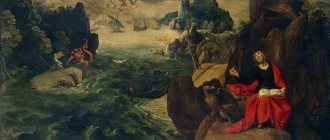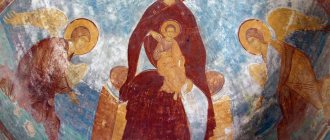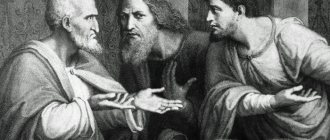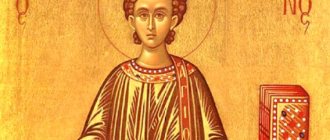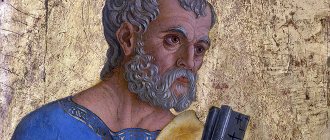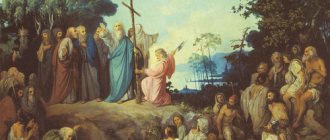Handwritten icon of St. Dionysius the Areopagite. The image is made on a linden board with oak dowels, linen felt, chalk gesso, gold leaf, tempera, drying oil, varnish.
Icon painting workshop Radonezh August, 2021. Sergiev Posad.
- Iconography of Dionysius the Areopagite
- Life of the Hieromartyr Dionysius the Areopagite
- How does the image of Dionysius the Areopagite help?
- Buy an icon of Dionysius the Areopagite
- Which icon to buy as a gift
- Calculate the cost of an icon
The icon of St. Dionysius the Areopagite, presented on our website, embodies the most characteristic, canonical image of the saint.
According to tradition, on icons, Dionysius the Areopagite is depicted in liturgical vestments (chassis, epitrachelion, belt, armbands, club, phelonion (simple or baptized), omophorion. White hood (doll), or without it. In boots. With a blessing right hand and the Gospel in the left hand.
The oldest description of the life of the holy martyr Dionysius the Areopagite, according to Church tradition, was compiled by Equal-to-the-Apostles Methodius of Constantinople in the 9th century. The earliest of the Byzantine iconographic originals that have reached us (in the passage “From the Antiquities of Church History of Ulpius the Roman on the Appearance of the God-Bearing Fathers”), dating from 993, conveys a description of the appearance of St. Dionysius, preserved for centuries in the reverent memory of the Church of Christ.
The icon shown above depicts the waist-length figure of the holy martyr Dionysius. The saint is dressed in liturgical vestments. The blue robe represents Heavenly purity. The color scheme of the icon is subordinated to the overall harmony of the image, successfully built on the contrast of the blue, white and gold background of the icon. In his left hand the saint holds a closed Gospel. The right hand is folded in a blessing gesture.
Correct, harmonious facial features personify the spiritual beauty of a celestial being. A stern facial expression, without excessive sensuality and emotionality, shows detachment from the world, concentration in serving the Lord. The face is painted with delicate ocher melts. The pinkish tones of the blush and lips contrast with the olive color of the sankir, which gives the face additional volume and expressiveness, softness and warmth.
Straight and wide folds of clothing set a certain rhythm and movement of the icon, expressing the complete orderliness of spiritual forces. Their strict geometric structure reveals the elasticity of spiritual energy. All elements of the icon are painted with thin, transparent melts, which give depth, softness, and unearthly airiness to the appearance of Dionysius the Areopagite.
The icon of St. Dionysius the Areopagite is made in the canonical style, in compliance with the centuries-old traditions of icon painting. When painting the icon, a pure and natural palette of colors was used: minerals, semi-precious stones, ocher, earths manually ground with a chime and mixed with yolk. The rich color palette of natural pigments made it possible to achieve moderate saturation and softness of colors characteristic of the Moscow school of writing.
Hieromartyr Dionysius the Areopagite, life
The memory of the Hieromartyr Dionysius the Areopagite is celebrated on October 16. Saint Dionysius was a disciple of the Apostle Paul and the first bishop of Athens. In 95, he was sent by Holy Pope Clement at the head of a mission to preach in Gaul, where he died during the persecution of Domitian around 96.
Hieromartyrs Dionysius the Areopagite, Bishop of Athens, Presbyter Rusticus and Deacon Eleutherius were killed in Gallic Lutetia (the ancient name of Paris) in 96 (according to other sources - in 110), during persecution under the emperor Domitian (81-96). Saint Dionysius lived in the city of Athens. There he was brought up and received a classical Hellenic education. Then he went to Egypt, where he studied astronomy in the city of Iliopolis. Together with his friend Apollophon, he witnessed a solar eclipse at the time of the crucifixion of the Lord Jesus Christ. “It is either God, the Creator of the whole world, who suffers, or this visible world ends,” Dionysius said then. In Athens, where he returned from Egypt, he was elected a member of the Areopagus (the supreme court of Athens).
When the holy Apostle Paul preached in the Athenian Areopagus (Acts 17:16-34), Dionysius accepted this saving gospel and became a Christian. For three years, Dionysius was a companion of the holy Apostle Paul in preaching the Word of God. Subsequently, the Apostle Paul made him bishop of the city of Athens. In the year 57, Saint Dionysius was present at the burial of the Most Holy Theotokos.
Even during the life of the Mother of God, Dionysius the Areopagite, who specially came to Jerusalem from Athens to see the Mother of God, wrote to his teacher the Apostle Paul: “I am testified by God that, besides God Himself, there is nothing in the universe so filled with Divine power and grace. No man can comprehend with his mind what I saw. I confess before God: when I was brought before the face of the Blessed Virgin by John, shining among the apostles, like the sun in the sky, I experienced an inexpressible feeling. Some kind of Divine radiance shone before me. It illuminated my spirit. I felt the fragrance of indescribable aromas and was filled with such delight that neither my weak body nor my spirit could bear these signs and the firstfruits of eternal bliss and Heavenly glory. From Her grace my heart fainted, my spirit fainted. If I had not remembered your instructions, I would have considered Her to be the true God. It is impossible to imagine greater bliss than what I felt then.”
After the death of the Apostle Paul, wishing to continue his work, Saint Dionysius went preaching to Western countries, accompanied by Presbyter Rusticus and Deacon Eleutherius. He converted many to Christ in Rome, and then in Germany and Spain. In Gaul, during the persecution of Christians by pagan authorities, all three confessors were captured and thrown into prison. At night, Saint Dionysius performed the Divine Liturgy in the co-service of the Angels of God. The next morning the martyrs were beheaded. Saint Dionysius took his head, walked with it to the temple, and only there he fell dead. The pious woman Catulla buried the remains of the martyr.
The works of Saint Dionysius the Areopagite are of great importance for the Orthodox Church. Four of them have survived to this day: “On the Heavenly Hierarchy”, “On the Church Hierarchy”, “On the Names of God”, “On Mystical Theology”, as well as ten epistles to various persons.
The book “On the Heavenly Hierarchy” was probably written in one of the countries of Western Europe, where Saint Dionysius preached. It sets out the Christian teaching about the world of angels. The Angelic (or Heavenly) hierarchy consists of nine Angelic ranks: Seraphim, Cherubim, Thrones, Dominions, Powers, Powers, Principalities, Archangels, Angels (Council of the Ethereal Heavenly Powers - November 8.)
The goal of the God-established Angelic Hierarchy is the ascent to Godlikeness through purification, enlightenment and improvement. The highest faces become carriers and sources of Divine Light and Divine life for the faces of the subordinates. Not only intelligent, ethereal forces are included in the luminous spiritual hierarchies, but also the human race, being recreated and sanctified in the Church of Christ.
The book of Saint Dionysius “On the Church Hierarchy” is a continuation of his book “On the Heavenly Hierarchy”. The Church of Christ in its worldwide service is based, like the angelic faces, on the Divinely established hierarchy.
Divine grace descends covertly into the earthly world, to the children of the church, in the holy sacraments of the church, spiritual in essence, but sensual in image. Only a few holy ascetics saw with earthly eyes the fiery nature of the Holy Mysteries of God. But outside of the Church Sacraments, outside of Baptism and the Eucharist, there is no luminous saving grace of God for a person, no knowledge of God, no deification.
The book “On the Names of God” sets out the paths of knowledge of God through the Ladder of Divine Names.
The book of Saint Dionysius “On Mystical Theology” also expounds the doctrine of the knowledge of God. The theology of the Orthodox Church is all based on the experiential knowledge of God. To know God, you need to get closer to Him, achieve a state of communion with God and deification. This is most achieved through prayer. Not because through prayer we bring the Incomprehensible God closer to us, but because pure heartfelt prayer brings us closer to God.
The works of Saint Dionysius the Areopagite (they are called “Areopagitiki”) are of exceptional importance in the Theology of the Orthodox Church. For almost four centuries, until the beginning of the 6th century, the works of the holy father were preserved only in secret tradition, mainly by theologians of the Alexandrian Church. They were known to Clement of Alexandria, Origen, Dionysius the Great, who successively headed the catechetical school in Alexandria, and Saint Gregory the Theologian. Saint Dionysius of Alexandria wrote interpretations of the Areopagitica to Saint Gregory the Theologian. The works of Saint Dionysius the Areopagite received churchwide recognition in the 6th–7th centuries. Particularly famous are the commentaries on them written by the Monk Maximus the Confessor († 662).
In the Russian Orthodox Church, the teaching of St. Dionysius about the spiritual hierarchy and the deification of human nature was first known from the “Theology” of St. John of Damascus. The first Slavic translation of the Areopagitika itself was made on Mount Athos ca. 1371 by the monk Isaiah. His lists were widely distributed in Russia. Many of them are preserved to this day in domestic book depositories - including the parchment manuscript of “The Works of St. Dionysius the Areopagite,” which belonged to St. Cyprian, Metropolitan of Kyiv and All Rus' († 1406) and was written by his hand.
To date
The place where the icon of Dionysius “Christ Descending into Hell” is located is the “Russian Museum”, a historical complex in the city of St. Petersburg, founded by order of Alexander III and began its activities in 1895 by order of Nicholas II.
A few years before his death, Dionysius moved to Belozerye with his sons, who became successors to their father’s craft, where one of the best temple paintings in the Ferapontov Monastery was created for the glory of God. The UNESCO Committee on Creative Heritage included this mural on the UNESCO World Heritage List in 2000.
Icons are not just images of saints or painted scenes, decoration of churches and monasteries. They come to life and answer our requests if the heart truly believes, strives for spiritual purity and conversation with God and the saints.
How does the icon of St. Dionysius the Areopagite help?
Through His saintly icons, the Lord sends us what we ask for, useful for our souls. The saints, just like us, who have walked the earthly path, know our needs. They experienced the same experiences, overcame similar earthly difficulties. When we ask a saint for intercession, we ask that he convey our prayer to God and that the saint’s prayers will be heard faster than our sincere appeal to them. The icon of Dionysius the Areopagite helps to establish a prayer connection with the patron saint. Having before us the visual image of the Apostle Dionysius, our prayer is not dissipated into empty ideas and dreams. And according to the faith of the one who asks, the Lord, through His saints, gives us what we ask.
They pray to Saint Dionysius the Areopagite:
— About strengthening faith — About help in organizing earthly affairs — About healing of bodily and spiritual infirmities.
Truly wonderful is God in His saints! Dear believers, brothers and sisters! Do not doubt the help of Saint Dionysius! Open your heart to him in sincere prayer and he will hear us, heal spiritual and physical infirmities, and help in the successful arrangement of earthly affairs.
Do not forget that in order for a miracle to happen, we ourselves must take care: regularly, with attention, read the prayer, do deeds of faith and love. And don’t forget to give thanks: to thank all the people sent to us by the grace of God to solve our life’s troubles, who shared our joy and sorrow. To thank the Saint, whose prayerful support our heart yearned for, because how many people pray to him for help, but he heard and helped us too. And most importantly, thank the Lord for His boundless love for mankind. He gave the world His saints and every second helps us, people who hope for His great mercies.
Everything in the world happens according to the wise providence of God. Difficulties and sorrows, success and joys. Through earthly trials the Lord strengthens us. By helping each other, praying to the heavenly saints, we are more firmly united in the One Church of Christ. And we believe that Saint Andrew will hear all our prayers and show us the boundless mercy of our Lord Jesus Christ. Thank God for everything!
DIONYSIUS
St. Dionysius Glushitsky. Icon. Ser. XVII century (VGIAHMZ)
St. Dionysius Glushitsky. Icon. Ser. XVII century (VGIAHMZ)
Among the images of other Vologda saints, D. is distinguished by its richness and diversity. This was reflected, in particular, in the iconographic originals of the 17th-19th centuries, where the appearance of D. is described in detail, with references to the Prologue, and is likened to the appearance of various saints - usually the Venerable Sergius of Radonezh, Varlaam of Khutyn or Cyril of Belozersky. So, for example, in the original of the 2nd quarter. XVII century under June 1, it is said about D.: “Rus, brada with Sergiev” (RNB. Sof. 1523. L. 168 vol.); in the manuscript last. thirds of the 17th century: “The one who sat above, like Varlaam of Khutyn, the schema on his shoulders” (RNB. Pogod. 1930. L. 130); in the consolidated original by G. D. Filimonov of the 18th century. in more detail: “Likewise: light-blond hair, with a little gray hair, long hair down to the chest and thick, venerable robe. According to the Prologue: the saint’s appearance is small in body and too dry in flesh, his head is not small, his eyebrows are surrounded, his face is long, his face is dark, his eyes are quiet, his hair is thick to his chest, his hair is half-gray” (Filimonov. Iconographic original. P. 358; cf. also: Bolshakov. Original icon painting. P. 104); in the Vygov manuscript, 3rd quarter. XVIII century under November 23: “In the likeness of Kirill Belozersky, a larger, round brad” (RNB. O.XIII.1. L. 123 vol.); in the original of the 40s. XIX century: “Rus, brother of Basil of Caesarea” (IRLI (PD). Department of receipts. Op. 23. No. 294. L. 178 vol.). An opinion has been expressed about the contamination of the description of the saint in the originals with the image of St. Kirill Belozersky, which is attributed to the authorship of D. (icon of 1424? (Tretyakov Gallery) - Antonova, Mneva. Catalog. T. 1. P. 305-307. Cat. 246). In the manual for church artists of 1910, it was proposed to depict the saint in a similar way: “Russian-type, short in stature, very thin in body, large head, oblong face, sunken cheeks, modest eyes, round eyebrows, thick beard to the collarbone, light brown hair, with a lot of gray hair; monastic robes and stoles. In your hands you can write a charter with his saying: Brothers, you see our enemies fighting, and we will not be afraid of them” (Fartusov. Guide to the Writing of Icons. P. 301).
The earliest known images of D. are on the northern icon of the ser. XVI century from the collection of A.I. Anisimov (the saint is presented frontally in full view) and among other Russian. saints - on the two-row icon “Selected Saints” con. XVI century works by the master of the Trinity-Sergius Monastery from the collection of A. M. and A. V. Maraevs (both in the collection of the Tretyakov Gallery) (Antonova, Mneva. Catalog. T. 2. P. 184-185, 240. Cat. 587, 662). Among others is Byzantine. and Russian His figure of saints is carved on one of the tombs of the 2nd floor. XVI-XVII centuries on a hanging shroud from the 80s and 90s. XVIII century (GMMK, see: Royal Temple: Shrines of the Annunciation Cathedral in the Kremlin: Cat. exhibition / GMMK. M., 2003. pp. 339-341. Cat. 119). The group of individual images includes a life-size image of the 17th century. (VGIAHMZ) - D.’s blessing right hand is set aside, in the other hand there is an unfolded scroll with the text: “Do not grieve, my brethren, but therefore it is reasonable for you to do even my deeds...” Judging by the size , the icon could be located in the local row of the iconostasis of one of the churches of the Glushitsky Sosnowiet Monastery. A 17th century analogue icon comes from this monastery. (VGIAHMZ) in a basma frame with a half-length depiction of D. blessing, holding a scroll unfolded upward under the image of the New Testament Trinity in a sphere supported by angels. A similar half-length depiction of the saint is on an icon from the 17th century. from c. St. John the Baptist in Dudikova is empty. Vologda (VGIAHMZ), as well as on the icon of the 2nd half. XVII century from the aisle D. to the c. St. Sergius of Radonezh in the Kirill Belozersky Monastery (KBMZ) - the saint has dark hair and a long, almost straight beard, a scroll is rolled up in his hand (Rybakov. 1995. Cat. 30).
Life icon last. Thursday XVII century (VGIAHMZ) entered the museum from the village. Great Courtyard of Sokolsky district, Vologda region. According to N.I. Fedyshin, the icon was in the iconostasis of the stone cathedral of the Glushitsky Sosnowiet Monastery, and after its closure it was transferred by the church watchman to the basement of the church, which has survived to this day. time wooden c. in the name of Reverends D. and Amphilochius Glushitsky. Undoubtedly, the icon was created in one of the mon-rays founded by D. - perhaps as a temple image built in 1661 in the Glushitsky Pokrovsky mon-ray church. in the name of Saints D. and Amphilochius.
In the center of the icon D. is depicted full-length together with St. Amphilohiem in tradition. monastic vestments, praying to the Savior in the clouds. Around the image there are 18 hagiographical marks in the following order: 1. D. and Pachomius are building a c. in the name of St. St. Nicholas the Wonderworker in Glushitsa. 2. Rostov bishop. Gregory blesses the saint. 3. D. erects a cross on Glushitsa. 4. The saint sets up a cell “near the bird cherry tree.” 5. The angel commands D. to put the c. in honor of the Intercession of the Mother of God and blesses it. 6. D. blesses the “workers” of the church. 7. The saint erected a church. in honor of the Intercession of the Virgin Mary. 8. D. consecrates the Pokrovskaya Church. and creates a monastery. 9. D. “excavated” his own grave in Sosnowiec. 10. During prayer, a saint sees demons and casts them out. 11. St. Paul the hermit accepts the blessing of D. 12. The saint blesses St. Amphilochia. 13. D. gives the cell to the saint. Amphilochia. 14. D. blesses and “entrusts” the brethren to St. Amphilochia. 15. The saint prays to the Most Holy One. Theotokos for peace and salvation. 16. Repose of D. 17. The coffin of the holy “lucky man” to the Sosnovets monastery. 18. Burial of D. at Sosnowiec.
Venerable Dionysius and Amphilochius of Glushitsky, with 18 hallmarks of life. Icon. Last Thursday XVII century (VGIAHMZ)
Venerable Dionysius and Amphilochius of Glushitsky, with 18 hallmarks of life. Icon. Last Thursday XVII century (VGIAHMZ)
The iconographic program of the marks is based on the Life of D.: here the images of the saint’s birth, learning to read and write, and tonsure are omitted; the story begins directly with D.’s arrival on St. Luke and the construction of the church. in the name of St. Nicholas. The author pays special attention to stories that are accompanied by heavenly signs and tell about the founding of monasteries and the construction of temples, as well as the gift of mentoring from the saint. Several The stamps are dedicated to the story of the death of D. A peculiarity of the iconography is the absence of images of miraculous healings at the saint’s tomb. Nothing is said about the saint as a talented icon painter, which is apparently explained by the master’s exact adherence to the text of the Life (even in detail - for example, the arrangement of the cell “at the bird cherry tree”). Stamp with the image of D. painting a “portrait” of St. Kirill Belozersky, placed on the door of the icon case in 1614, a letter from N. Ermolov from the c. St. Kirill Belozersky Kirillov Belozersky Monastery (KBMZ), created for the icon of 1424 (?) (Antonova, Mneva. Catalog. T. 1. P. 306; Rybakov. 1995. Cat. 29). Scenes from the Life of D. are also found in the paintings of the 2nd half. XIX century Vologda center ap. Andrew the First-Called in Fryazinov.
A special group consists of full-length images of D. (usually on the left side of the composition) together with his student, St. Amphilohiem. On the icon of the 17th century. from c. ap. St. Andrew the First-Called in Fryazinov in Vologda (VGIAHMZ) The Glushitsa miracle workers stand before the Holy Trinity of the New Testament, in the lower part there is a view of the monastery they founded (on the record of the 19th century there is a 2-story, 5-domed cathedral with an adjacent 3-tier bell tower). On a similar icon of the 18th century. (GRM) with the image of the monastery, the saints turn in prayer to the Savior Emmanuel, on the icon-Pyadnitsa beginning. XVII century from the Glushitsky Sosnovetsky Monastery (VGIAHMZ) - to the Image of the Savior Not Made by Hands, below between them is a 6-sided well under the canopy (possibly the over-storey chapel of the monastery). On the back of the double-sided icon “Savior Not Made by Hands. Venerable Dionysius and Amphilochius of Glushitsky" ser. XVIII century (CMiAR) the saints are presented against the background of a conventional landscape, drawn from an 18th century image. (?) (Russian Museum) they support with their hands the monastery with the 5-domed cathedral (Markelov. Saints of Ancient Rus'. T. 1. P. 93). 19th century image (VGIAHMZ), unlike most images, represents the saints in the form of gray-haired elders, D.’s left hand is pressed to his chest, his right hand is lowered with an open palm.
Depiction of D., in monastic robes, with his head uncovered, with a dark beard of medium size, usually next to the saint. Amphilohiem, found in plural. icons of the Savior Almighty with the coming and falling Vologda miracle workers, originating from the churches of Vologda (currently in the collection of VGIAHMZ): for example, on the image of the 3rd quarter. XVII century (under the entry of the 19th century) from the iconostasis of the Cathedral of the All-Merciful Savior in the Demetrius Prilutsky Monastery; on an 18th century icon from c. Meeting of the Vladimir Icon of the Mother of God - in the right group in a bow; on an 18th century icon from c. Nativity of the Virgin Mary in the cemetery - among the 4 most revered local saints, in kneeling prayer together with St. Amphilohiem; on an 18th century icon from Trinity (Gerasimovskaya) church. on Kaysar Creek; on the image of 1779 by Dimitry Sumarokov with his son Ivan from c. St. Nicholas the Wonderworker in Vladychnaya Sloboda; on an 18th century icon from c. Nativity of the Virgin Mary on the Upper Valley - in the right group of saints; on the image “Jesus Christ the Great Bishop, with the Vologda Wonderworkers” 3rd quarter. XVIII century - in the left group; on the icon of the beginning XIX century from the seminary center St. Kirill Belozersky and others. Deesis (Week) of the 17th century. from Dimitriev Prilutsky Monastery (VGIAHMZ) is supplemented with 2 figures of the most revered Vologda monks falling at the feet of Jesus Christ - Dimitri Prilutsky (left) and D. (right).
Icons of D. in prayer are part of 2 Deesis ranks of the iconostasis - ser. XVII century from the Glushitskaya Intercession Monastery (with an unrolled scroll in his hand) and con. XVII - beginning XVIII century from c. Dormition of the Virgin Mary of Alexandrov of the Kusht Monastery (both in the collection of the VGIAHMZ), in both cases D. is depicted on the left side of the Deesis. The monk is represented on the margin of the left fold of the fold ““He rejoices in You.” Saturday of All Saints. Six Days with Selected Saints” beginning. XVII century Stroganov workshop from the collection of P. M. Tretyakov (Tretyakov Gallery) - together with St. Dimitry Prilutsky (Antonova, Mneva. Catalog. T. 2. P. 352-353. Cat. 836). The image of D. is placed in the top row of the left group on the icon of selected saints of the 18th century. from c. ap. Andrew the First-Called in Fryazinov in Vologda (VGIAHMZ), as well as among the saints in the fields - on the image of the “Savior Not Made by Hands with Selected Saints”, 1st half. XVIII century from the Vologda center Presentation of the Lord (VGIAHMZ). On double-sided icons of the 18th century. (VGIAHMZ) with the image of the Smolensk Icon of the Mother of God (on the front side) D. is presented in prayer to the Savior together with St. Onuphrius the Great (on the back). In the mineain cycles, D. is depicted under June 1 next to the martyr. Justin of Rome - for example, on the Menaion icon of the con. XVI century and on carved wooden calendars of the 17th century. (VGIAHMZ).
Mch. Justin of Rome and St. Dionysius Glushitsky. Fragment of an engraving by G. P. Tepchegorsky. 1722 (GLM)
Mch. Justin of Rome and St. Dionysius Glushitsky. Fragment of an engraving by G. P. Tepchegorsky. 1722 (GLM)
In monumental painting, a bust-length image of D. in a medallion is found in paintings of 1686-1688. St. Sophia Cathedral in Vologda - in the chapel of St. John the Baptist (in the deacon) to the east. the wall under the conch. In the picturesque decoration of the Cathedral of Christ the Savior, the image of the Glushitsky Wonderworker was placed among other Russian. saints - in zap. arch of the aisle of the bldg. led book Alexander Nevsky (70s of the 19th century, artist V.D. Fartusov) (M. S. Mostovsky, Cathedral of Christ the Savior / [Compiled conclusion. Part. B. Sporov]. M., 1996, p. 77 ).
In the Pomeranian compositions “The Council of Russian Saints” D. is presented in the right group of saints at the head of the 3rd row, next to St. Korniliy Komelsky and other Vologda miracle workers: on the icon. XVIII - beginning XIX century (MIIRK); on the image of 1814, a letter from Peter Timofeev from the collection of the Central Academy of St. Petersburg (St. Russian Museum; see - Markelov. Saints of Ancient Rus'. T. 1. P. 454-455) - bust-length, with a bare head and a small beard, the right hand is raised with two fingers; on the icon 1st half. XIX century from the village Chazhenga, Kargopol district, Arkhangelsk region. (Tretyakov Gallery) - half-length image with hands raised in prayer. The icon shows the 1st floor. XIX century from the Old Believer prayer house at the Volkov cemetery in St. Petersburg (GMIR) - D. in the right group of reverends is the last in the 3rd row, hair and beard streaked with gray, inscription: “p Deonisia Glushidsi.” The icon of this plot shows the middle - 2nd floor. XIX century (TG) the saint is written in the 5th row, 4th from the left, also half-turned to the center; on the icon of the beginning XIX century from Chernivtsi region (NKPIKZ) his figure with a blessing right hand and a scroll in his left hand is placed 2nd from the left in the 1st row.
In church art of the 20th century. D.'s image is found in the group of Vologda saints (far left in the 1st row, with covered hands) on the icon “All the saints who shone in the Russian land” con. 20s - early 30s letters mon. Juliania (Sokolova) (TSL sacristy) and on its repetitions (Aldoshina N. E. Blessed Work. M., 2001. P. 231-239); in the drawings for the publication of liturgical Menyas by Rev. Vyacheslav Savinykh - on June 1 individually in growth and on October 12. together with Rev. Amphilohiem (Images of the Mother of God and saints of the Orthodox Church. M., 2001. P. 246, 44); on a bronze relief in the lower part of the cross, installed in 1997 on the site of the All-Grad Cathedral in the name of the All-Merciful Savior in Vologda (sculptor A. V. Klimkov), - together with St. Grigory Pelshemsky; on a tiled relief with a view of the Dionysian Glushitsky Monastery, 1999, by Klimkov (private collection) in a series of images in Russian. Mont Rey and their founders; in painting 2005 c. The Vladimir Icon of the Mother of God in Optina Vvedenskaya is empty. (with an icon of the Mother of God in hand).
Lit.: Ratshin A. Complete collection. historical information about all ancient and currently existing monasteries and notable churches in Russia. M., 1852. P. 218; Suvorov N.I. Glushitsky monastery of the Vologda diocese // Vologda EV. 1876. No. 16. P. 228-238; No. 17. P. 247-255; No. 18. P. 257-267; No. 19. P. 271-277; No. 20. P. 292-303; No. 21. P. 328-344; No. 22. P. 355-383; No. 23. P. 388-391; Stepanovsky I.K. Vologda antiquity: Historical-archaeological. Sat. Vologda, 1890. pp. 242-249, 478; Picturesque Russia. St. Petersburg, 1904. P. 52-71; Izvestia Imp. Archaeol. commissions. Pg., 1915. Issue. 59. pp. 188-189; Antonova, Mneva. Catalog. T. 1. pp. 305-307. Cat. 246; T. 2. pp. 184-185, 240, 352-353. Cat. 587, 662, 836; St. Sergius of Radonezh: Album / Author-comp.: N. N. Chugreeva. M., 1992. S. 192-193. Il. 104, 105; Rybakov A. A. Vologda Icon: Artist Centers. culture of the land of Vologda XIII-XVIII centuries. M., 1995. Cat. 29, 30; Markelov. Saints Dr. Rus'. T. 1. P. 92-93, 454-455; T. 2. P. 97-98, 288-289; Kochetkov. Dictionary of icon painters. pp. 143-144; St. Dimitry Prilutsky, Vologda miracle worker: To the 500th anniversary of the Meeting of the Miracles. image of June 3, 1503. M., 2004. P. 85, 89, 91-97, 106, No. 26, 31, 35-42, 56.
T. G. Petrova
Buy an icon of St. Dionysius the Areopagite
In the Radonezh icon painting workshop you can buy or order a handwritten icon of St. Dionysius the Areopagite. Call us and we will help you choose a plot, a compositional solution for the icon, its optimal size and design, or we will write an icon according to your sample.
Free delivery throughout Russia.
If desired, the icon can be consecrated in the Holy Trinity Sergius Lavra.
The image of the holy martyr Dionysius the Areopagite, made by the icon painters of the Radonezh workshop, like any handmade icon, carries within itself the living warmth of human hands and a loving heart. Each icon painted with love is unique and inimitable.
Peace and goodness to you Dear brothers and sisters, and may the holy saint of God, Dionysius the Areopagite, accompany you throughout your entire life’s journey.
Similar icons:
Anthony the Great 13000 ₽
Maxim Confessor 13000 ₽
Nicholas the Wonderworker (shoulder) 15000 ₽
Tamara Queen 13000 ₽

